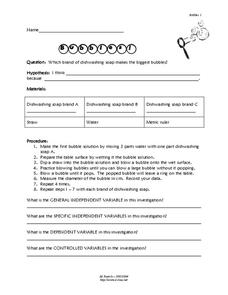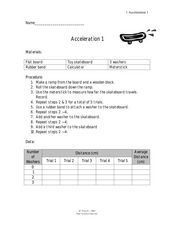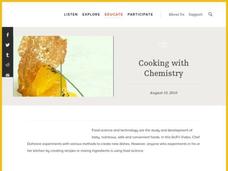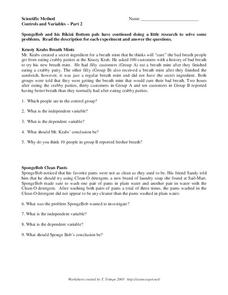Curated OER
Bubbles
Students experiment bubbles. In this scientific method lesson, students identify variables used in proper experiment design. Students conduct experiments with different brands of dish-washing detergent to determine which brand makes the...
Curated OER
Altering a Plant Environment
Learners investigate what a controlled group is by creating an experiment. In this plant growth instructional activity, students identify the different parts of a plant and discuss what is needed for a plant to be successfully...
Curated OER
Weather Experiment Plan
In this weather experiment activity, students design an experiment that allow them to experiment a phenomenon of weather. Students identify the independent and dependent variable for their experiment. Students list the procedures as well...
SurfScore
Kodable
Prepare young scholars for life in the twenty-first century with this introduction to computer coding formatted as a fun problem solving game, this resource is a great way to develop children's sequential thinking...
Curated OER
I'm Inclined to See; Physics, Math, Science, Experiments, Graphs
Students discover the motion of a sphere on an inclined plane and discover basic relationships involving distance, time, speed(velocity), and acceleration.
Curated OER
Acceleration 1
In this acceleration worksheet, students use weights to increase the mass affecting the force on moving objects. Students plot a graph of their data and answer 3 questions about how the acceleration of the toy skateboard used in the...
Curated OER
Forming a Scientific Investigation
In this scientific investigation worksheet, students conduct scientific investigations on what happens to the speed of a marble when the height of a ramp is changed, what happens when you add salt to water, and 3 other experiments....
Curated OER
The Earth around Us: Air, Water & Soil
Students recognize that science is everywhere. For this scientific method lesson, students experiment with height and record their experiment using the scientific method. Students must identify each step of the...
Curated OER
GROWING PLANTS UNIT
Students predict outcomes of scientific experiment,.conduct a scientific experiment with control groups, and plant seeds to observe, measure, and compare growth across groups. They gather, record, analyze, and share data with other...
Curated OER
Dirty Decomposers
Students explore the ecosystem by conducting a ziploc bag experiment. In this recycling lesson, students identify decomposer organisms in our environment and how they speed up the recycling process. Students utilize a ziploc plastic bag,...
Curated OER
Gas Laws
High schoolers perform a series of experiments on gas laws. For this chemistry lesson, students analyze the relationship between temperature, volume and pressure. They create a poster summarizing all the gas laws.
Curated OER
Acceleration 2
In this acceleration learning exercise, students experiment with varying amounts of mass to observe the effects on the force needed to move an object. Students apply Newton's Second Law of Motion to describe the relationship between mass...
Curated OER
Seed Germination
Students explore plants and the scientific method. In this plant growth lesson plan, students follow the steps in the scientific method to perform a seed germination experiment as a whole class. Students work in a group to create their...
Curated OER
The Nature and Science of Technology
Fifth graders practice using the scientific method by observing and creating mold. In this bacteria lesson, 5th graders experiment creating their own mold and fungus using petri dishes and oatmeal. Students create an...
Curated OER
Introduction to Scientific Investigation
What is a scientific investigation? What are the various parts of an experiment? This instructional activity provides a basic review of most key terms: scientific method, manipulated variable, responding variable, hypothesis, controlled...
Curated OER
Celery Lab
How do sugar and salt affect celery's mass, width, and flexibility? Using simple household ingredients, young scientists will perform a controlled experiment to find out. The lab is scaffolded through a activity, but there are no other...
Beyond Benign
In a Lather
Time to come clean! Scholars continue preparing the shampoo they created in the previous two lessons. The purpose of this stage is to calculate the perfect amount of additive to make the shampoo lather.
Science Friday
Cooking with Chemistry
Use class time to perfect your hollandaise sauce with a chemistry lesson. It includes two activities to teach about immiscible liquids, emulsifiers, and creating a stable homogenous mixture. Young scientists first mix...
Royal Society of Chemistry
Electrochromic Polymer—Chemistry Outreach
From windows that tint themselves to OLED technology, electrochromic polymers are redefining our ideas about conducting materials! Introduce your chemistry class to the emerging trend with an exciting lab activity. Budding materials...
Ohio State University
Ohm's Law
Have you ever wanted to build a conductor? Here is a lesson that takes pupils through building a conductor based on Drude's model in order to better understand electricity.
Curated OER
Viewing Bacteria
Have you ever wanted to know the true structure of E.coli? Does the thought of peering into its "small world" sound exciting? Here is a lesson that allows pupils the ability to do just that. Blossoming microbiologists use...
Curated OER
Where do Plants Get their Food?
In this where do plants get their food worksheet, young scholars design an experiment that will disprove the idea that plants obtain their food from soil. Students will set up their experiment and design a data table that will record...
Curated OER
Point Graphs
Students experiment with point graphs. In this math lesson, students are divided into groups and perform an experiment to see how high a ball bounces, recording their results on a point graph. Students then answer provided questions.
Curated OER
Scientific Method
In this Scientific Method worksheet, students identify controls, variables and conclusions given experiment descriptions. Students interpret data given in charts.

























